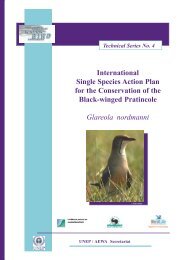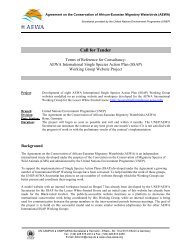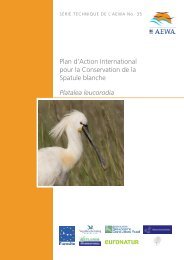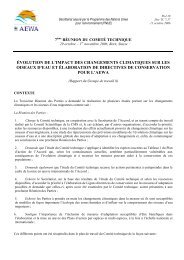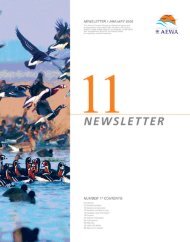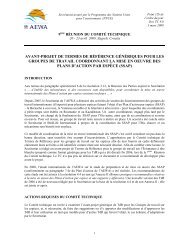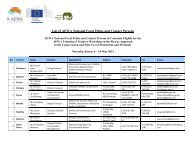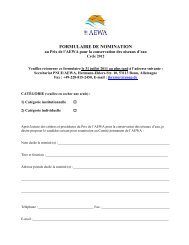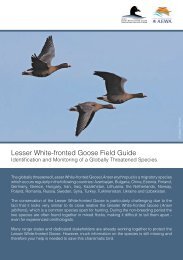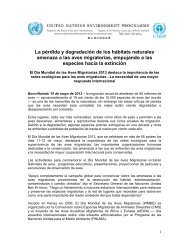PROPOSAL FOR INTERNATIONAL IMPLEMENTATION ... - AEWA
PROPOSAL FOR INTERNATIONAL IMPLEMENTATION ... - AEWA
PROPOSAL FOR INTERNATIONAL IMPLEMENTATION ... - AEWA
Create successful ePaper yourself
Turn your PDF publications into a flip-book with our unique Google optimized e-Paper software.
Secretariat provided by the<br />
United Nations Environment Programme<br />
(UNEP)<br />
Agenda item18<br />
Doc. StC 3.19<br />
25 June 2005<br />
Original: english<br />
THIRD MEETING OF THE STANDING COMMITTEE<br />
04 - 05 July 2005, Bonn, Germany<br />
<strong>PROPOSAL</strong> <strong>FOR</strong> <strong>INTERNATIONAL</strong> <strong>IMPLEMENTATION</strong> PRIORITIES<br />
<strong>FOR</strong> 2006-2008<br />
INTRODUCTION<br />
1. The following list of priority activities has been established to assist Contracting Parties, donors and other<br />
stakeholders to further the implementation of the Action Plan of the Agreement on the Conservation of<br />
African-Eurasian Migratory Waterbirds during the period 2006-2008.<br />
2. At the first session of the Meeting of the Parties (MOP) to the Agreement, which took place from 6 to 9<br />
November 1999 in Cape Town (South Africa), the international implementation priorities (IIP) for 2000-2004<br />
were adopted in Resolution 1.4. Updated IIP for 2003-2007 were adopted with Resolution 2.4 at MOP2 in<br />
Bonn in September 2002. The current proposal for IIP 2006-2008 represents a reviewed and upgraded list of<br />
activities from the previous IIP 2003-2007.<br />
<strong>IMPLEMENTATION</strong> PRIORITIES 2003-2007 AS THE BASIS<br />
3. In a separate document (<strong>AEWA</strong>/MOP3.12) the implementation status of the priorities over the period 2003-<br />
2007 is presented, focussing on actions undertaken or in progress within the <strong>AEWA</strong> framework (more may<br />
have been undertaken by individual countries or other agencies in a different context). Document<br />
<strong>AEWA</strong>/MOP3.12 shows that although there was considerable progress, many priorities have not yet been<br />
implemented, mainly because of a lack of funding. Priorities that have been or are currently being<br />
implemented do not re-appear in the present list of 2006-2008 priorities.<br />
CONSULTATION<br />
4. In order to identify necessary changes and additions that were needed to the existing implementation<br />
priorities, the <strong>AEWA</strong> Secretariat set up a wide consultation. The updated list of activities is based on an<br />
extensive consultation with the Range States, NGOs, scientific institutes and consultants. Comments and<br />
proposals were received from 3 Range States, 2 NGOs, 1 scientific institute and 2 consultants. However some<br />
of them were irrelevant to IIP as they were reflecting priority activities at national level only. Although quite<br />
a few of the activities from the list as adopted in 1999 and updated in 2002 have been implemented, the<br />
remaining list of activities is still valid.<br />
NATURE OF SUGGESTED CHANGES<br />
5. The external consultation network has proposed no suggestions to change existing priorities, while a<br />
number of additional priority activities were suggested. This initial list of additional projects was reviewed by<br />
the Technical Committee at its 6 th meeting and was reduced or some proposals were slightly modified to<br />
extend their scope (e.g. training courses on migratory waterbird conservation). Remaining proposed<br />
additional priorities are presented in Bold and Italics for discussion purposes. The Technical Committee<br />
introduced also several other modifications: wording of some of the previous priorities that remained in the
-2-<br />
document, especially such that are matching funding for the GEF project, was enhanced to<br />
reflect better current state; two of the previous priorities (guidelines on satellite telemetry and on telemetry in<br />
waterbirds) were merged into one priority.<br />
ORDER AND <strong>FOR</strong>MAT OF PRESENTATION<br />
6. As in the previous versions, the presentation of the priorities in the present document follows the headings<br />
of the Action Plan to the Agreement. The number(s) in parentheses after each priority title refer(s) to the<br />
relevant paragraph of the Agreement’s Action Plan. The order of presentation does not reflect any order of<br />
priority.<br />
7. For each priority, an indicative budget and timescale is presented for guidance, along with the types of<br />
activity involved. It should be noted that the budgets are only indicative. Detailed project proposals and<br />
budgets to meet each priority will be required at a later stage and should be the basis for the final fundraising.<br />
DISCUSSION<br />
8. During the 3 rd Session of the Meeting of the Parties to the Agreement, a discussion on priorities should take<br />
place and the Parties should establish a list of priorities. This document provides the basis for the discussion.<br />
9. The priorities include only those requiring international cooperation, and are not intended to reflect national<br />
implementation priorities, which must be determined by each Contracting Party and could include more onthe-ground<br />
conservation activities. A number of the proposals underlined the importance of such activities.<br />
Five types of international cooperation will be appropriate in addressing these priorities:<br />
(a) Exchange/transfer of information;<br />
(b) Research, surveys and monitoring;<br />
(c) Exchange/transfer of expertise;<br />
(d) Financial assistance;<br />
(e) Transboundary drafting and implementation of action plans<br />
ACTION REQUESTED FROM THE STANDING COMMITTEE<br />
The Standing Committee is requested to review this latest version of the proposal for International Implementation<br />
Priorities 2006-2008 as suggested by the Technical Committee, noting that the Secretariat is still working on<br />
finalisation in accordance with the changes made by the Technical Committee, to discuss and introduce amendment<br />
and/or changes (if applicable) and approve it for submission to the 3 rd Session of the Meeting of the Parties along<br />
with draft Resolution 3.8
-3-<br />
<strong>INTERNATIONAL</strong> <strong>IMPLEMENTATION</strong> PRIORITIES <strong>FOR</strong> 2006-2008<br />
A. SPECIES CONSERVATION<br />
1. Implement existing international single species action plans (AP 2.2.1, 7.4)<br />
Prior to the entry into force of the Agreement, a number of international single species action plans relevant<br />
to Paragraph 2.2.1 of the Agreement’s Action Plan had already been developed (by BirdLife International,<br />
Wetlands International and International Crane Foundation). These include action plans for: Phalacrocorax<br />
pygmeus, Pelecanus crispus, Botaurus stellaris, Anser erythropus, Branta ruficollis, Marmaronetta<br />
angustirostris, Polysticta stellerii, Grus leucogeranus, Fulica cristata, Numenius tenuirostris, Larus<br />
audouinii, and Sterna dougallii. (NB. Several of these action plans cover the European part of the range of<br />
the species only, and a priority is to extend them to cover their full range within the Agreement area (see next<br />
item). A number of international single species action plans were also adopted by MOP2 and MOP3 of<br />
<strong>AEWA</strong> for Vanellus gregarius, Glareola nordmanni, Gallinago media, Oxyura leucocephala, Crex crex,<br />
Aythya nyroca, Geronticus eremita, and Branta bernicla hrota (East Canadian High Arctic population), and a<br />
number of action plans are under preparation or are being updated, including for intra-African migrants, such<br />
as Oxyura maccoa, Anser erythropus, and Branta bernicla bernicla. Whilst many of the actions identified for<br />
these species will have to be undertaken and financed at national or local level, a budget is required for<br />
international coordination and promotion, and to provide small grants for national and local initiatives.<br />
Indicative budget:<br />
Duration:<br />
Activities:<br />
€ 50,000 min. /species / year (for coordination/grants)<br />
Annual, ongoing<br />
Coordination, small grants, evaluation, reporting<br />
2. Develop new international single species action plans (AP 2.2.1, 7.4)<br />
New international single species action plans need to be developed for the populations listed in<br />
category 1 of column A of Table 1 to the Agreement Action Plan as a priority, and for those species<br />
listed with an asterisk in column A of Table 1. Production and format of the action plans should<br />
follow the recommendations given in the relevant conservation guidelines. As soon as the new<br />
action plans are prepared for each species, implementation should begin. In view of the large<br />
number of action plans to be prepared, it is strongly recommended that the most urgent attention be<br />
given to globally threatened species. Furthermore, it is recommended that individual Range States<br />
agree to take the lead on development of individual action plans (as an in-kind contribution to the<br />
Agreement), in close cooperation with the other Range States for each species (coordination of plan<br />
development including workshops, drafting, consultation and publication of each plan). Plans should<br />
be submitted to the Technical Committee in draft form before final approval, to ensure<br />
harmonization and quality control.<br />
Indicative budget:<br />
Duration:<br />
Activities:<br />
€ 40,000 per species for action plan preparation<br />
12 months per plan<br />
Coordination, workshop, planning, publication<br />
B. HABITAT CONSERVATION<br />
3. Identify all sites of international importance for <strong>AEWA</strong> species (AP 3.1.2, 7.4)<br />
A vital piece of information for the conservation of any migratory species is an understanding of the network<br />
of key sites required to sustain their populations throughout the year. A large body of information already<br />
exists concerning key sites for migratory waterbirds (that is, sites which meet the Ramsar criteria of<br />
international importance for waterbirds and Important Bird Areas). This information has largely been<br />
collected through the International Waterbird Census of Wetlands International, but also through BirdLife<br />
International’s Important Bird Areas programme and Endemic Bird Areas programme, wetland inventories<br />
(particularly the Directory of Wetlands of the Middle East) and one-off surveys of remote areas. It is<br />
proposed to compile from these various existing sources a “matrix” of key sites by Species, which will show<br />
all known internationally important sites for each species covered by the Agreement. This matrix will be<br />
made available in database form through the World Wide Web as a planning, conservation and awareness
-4-<br />
tool. The successful presentation of the results of this activity depends on the completion of<br />
implementation priority number 4.<br />
Indicative budget: € 125,000<br />
Duration:<br />
2 years<br />
Activities:<br />
Desk study, review, database, web site<br />
Being proposed for matching funding as an activity in the full project proposal of the GEF<br />
<strong>AEWA</strong>/Ramsar flyways project to be launched in 2005.<br />
4. Creating an interactive tool that presents information on important sites for migratory waterbirds (AP 3.1.2,<br />
7.4)<br />
Currently large amounts of data exist in databases on migratory waterbirds (International Waterbird Census)<br />
and the sites they depend upon in the <strong>AEWA</strong> region (Important Bird Areas, Ramsar database). These data<br />
reside with the custodians and are not inter-operable at the moment. This hampers the interactive application<br />
of these data for flyway conservation purposes. Development of a web-based portal that can integrate data on<br />
sites of critical importance to migratory waterbirds from these dispersed sources and that provides the option<br />
of interactive data submission through the web, is a priority.<br />
A condition for increasing the ‘inter-operability’ of essential databases like the International Waterbird<br />
Census database and the Important Bird Areas database, but also the Ramsar database, is that they have<br />
common geographic references, in the form of digitized boundaries. These do not currently exist to a<br />
significant extent and considerable work will need to be done to create these, especially for the International<br />
Waterbird Census database. This will be a key activity in creating the tool.<br />
Indicative budget: € 215,000<br />
Duration:<br />
4 years<br />
Activities:<br />
Gathering of reliable map data, coordination, data input (digitization of<br />
boundaries); database adaptation, portal development, data management,<br />
maintenance<br />
Being proposed for matching funding as an activity in the full project proposal of the GEF<br />
<strong>AEWA</strong>/Ramsar flyways to be launched in 2005.<br />
5. Identify priority areas for further survey work (AP 3.1, 7.4) 1<br />
Based on the study undertaken in Implementation priority number 3 above, a gap analysis should be<br />
undertaken to identify sites/regions where migratory waterbirds would particularly benefit from further<br />
surveys. This would be achieved by asking species experts and national focal points to comment on maps<br />
based on existing knowledge, and to identify areas of potential importance for migratory waterbirds, but for<br />
which survey data are lacking. This would also include identification of areas important for dispersed species<br />
(e.g., waders and Anatidae during their breeding season) or very large, complex or composite sites. The<br />
results will be used both to stimulate “expedition” work in remote areas, as well as to identify countries<br />
which would most benefit from a national wetlands inventory programme.<br />
Indicative budget: € 50,000<br />
Duration:<br />
2 years<br />
Activities:<br />
Desk study, consultation, review, publication, survey proposals<br />
Being proposed for matching funding as an activity in the full project proposal of the GEF<br />
<strong>AEWA</strong>/Ramsar flyways project to be launched in 2005.<br />
6. Identify priority areas for better protection (AP 3.2, 7.4) 2<br />
1 The Secretariat is working with Wetlands International on rewording of the title<br />
2 The Secretariat is working with Wetlands International on rewording of the text
-5-<br />
Based on the study undertaken in implementation priority number 3 above, the key sites matrix will be<br />
examined to ascertain the degree of existing protection of each site under both international and national<br />
legislation. At the international level, this will be achieved by comparison with existing databases on<br />
protected areas (e.g. the Ramsar sites database (maintained by Wetlands International), the Natura<br />
2000/Special Programme of Action databases of the European Commission, and the protected areas database<br />
(maintained by the World Conservation Monitoring Centre). At national level, information will also be<br />
requested from national focal points for the Agreement. The results will be used to assess whether adequate<br />
site protection measures are in place to maintain each species under the Agreement in a favourable<br />
conservation status. Specific recommendations will be made for species where the network of key sites is<br />
thought to be inadequately protected. The study will also list those key sites which are shared between two or<br />
more countries, and which require special cooperation measures for effective management.<br />
Indicative budget: € 70,000<br />
Duration:<br />
2 years<br />
Activities:<br />
Desk study, review, publication, and recommendations<br />
Being proposed for matching funding as an activity in the full project proposal of the GEF<br />
<strong>AEWA</strong>/Ramsar flyways project to be launched in 2005.<br />
7. Habitat Priorities for Waterbirds, particularly in Africa and South-west Asia(AP 3.2, 3.3) 3<br />
The BirdLife International project Habitat Action Plans for Birds in Europe, has made an important<br />
contribution to defining habitat conservation priorities for birds in Europe. This now needs to be made much<br />
more specific to waterbird habitats and, particularly, to be extended to Africa and South-west Asia, where<br />
habitat requirements are much less well known. The project should result in a series of habitat action plans<br />
containing prioritised recommendations and costed projects for each key habitat type. Severely threatened<br />
habitats, and habitats of importance to globally threatened species, should be given priority.<br />
Indicative budget: € 200,000<br />
Duration:<br />
3 years<br />
Activities:<br />
Desk study, review, workshops, publication, project proposals<br />
8. Restoration and rehabilitation techniques for waterbird habitats, particularly in Africa (AP 3.3) 4<br />
There has been significant loss and degradation of waterbird habitats throughout the Agreement area.<br />
Techniques are relatively well developed for the restoration and rehabilitation of wetlands in temperate<br />
regions, but are poorly developed or known for wetlands in the tropics. It is therefore proposed to draw<br />
together the available information to produce two manuals (one for temperate and one for tropical areas),<br />
including information on the sources of available expertise. Close coordination will be necessary with<br />
existing work under the Ramsar Convention. Because of the paucity of information on restoration of tropical<br />
waterbird habitats, a special project will be launched to undertake demonstration restoration measures for a<br />
small number of African wetlands. These will also be used as a focus for training activities. Restoration<br />
techniques will focus on low-cost, low technology management options.<br />
Indicative budget:<br />
Duration:<br />
Activities:<br />
€ 60,000 per manual<br />
€ 80,000 minimum for each demonstration project<br />
18 months for the manuals<br />
Manuals, demonstration projects, training courses<br />
9. Conservation programme of migratory bird roosting sites located in the Albertine Rift region<br />
(Eastern Africa) (AP 3.2.3, 3.2.4) 5<br />
The Albertine Rift region is an important north-south flyway for migratory birds from Europe<br />
heading to their wintering places in the southern part of the African Continent. This part of<br />
3 The Secretariat is working with Wetlands International on rewording of the text<br />
4 The Secretariat is working with Wetlands International on rewording of the text<br />
5 Final decision of the Technical Committee on this proposal is pending upon submission on more information from the<br />
proponent
-6-<br />
Eastern Africa counts numerous important bird areas (IBAs) which make the Albertine Rift a<br />
global biodiversity hotspot. Two important factors weighing on the conservation status of these<br />
sites are extremely high human population densities and poverty that is rampant in the Albertine<br />
Rift region and neighbouring areas. Due to human pressure, all IBAs of the region face the<br />
following problems: encroachment for settlement, agriculture, cattle breeding and grazing,<br />
poaching, illegal harvesting, bush fires during the dry season etc., so that actually all these sites<br />
are getting more and more degraded.<br />
To overcome all above-mentioned problems and threats and contribute to poverty alleviation in<br />
the region, a conservation programme concerning protected and non-protected IBAs, led<br />
essentially by local populations including communities and local and traditional authorities, is<br />
intended in the respective countries, i.e. Burundi, Rwanda, Tanzania and Uganda. Identification<br />
of strategies and mechanisms for contributing to livelihood improvement of local people and<br />
safeguarding the ecosystem qualities of IBAs is expected as well as efficient collaboration of<br />
riparian communities with national and regional conservation authorities.<br />
Indicative budget:<br />
Duration:<br />
Activities:<br />
€ 712,000; four fifth of total amount (€ 570,000) to be sourced from<br />
<strong>AEWA</strong><br />
3 years<br />
Coordination of collaborators, analysis<br />
10. Identify the River Danube for international importance for <strong>AEWA</strong> species 6<br />
It is well known that a great number of waterbirds which are listed in column A of Table 1 to the<br />
Action Plan of the Agreement as priority species winter on big lakes and rivers such as the<br />
Danube. Up to 75% of the European population of some species (e.g. Mergus albellus,<br />
Buccephala clangula, Aythya nyroca, Clangula hyemalis) winter on this river. Because of this it<br />
is necessary to conduct more intensive monitoring of non-breeding migratory waterbird<br />
population through the International Waterbird Census of Wetlands International. Collected data<br />
will be used for better protection of the regions that are rich in species at both international and<br />
national levels. At the international level, this will be achieved by a mutual comparison of the<br />
results gathered down the Danube’s flow, which will show the richness of its regions in species<br />
and necessary improvements in protecting measures by comparison with other protected area<br />
databases (e.g. the Ramsar sites database or the World Conservation Monitoring Centre). At<br />
national level, information will be used for the national focal point for the Action Plan of the<br />
Agreement. Also, results will be used for the valorisation of the existing protection measures on<br />
the River Danube, related to waterbirds from the Agreement. A budget is required for<br />
international coordination and promotion, and to provide small grants for national, local<br />
monitoring activities and for international cooperation.<br />
Indicative budget: € 112,000<br />
Duration:<br />
3 years<br />
Activities:<br />
Coordination, monitoring, recommendation<br />
C. MANAGEMENT OF HUMAN ACTIVITIES<br />
11. Evaluation of waterbird harvests in the Agreement area (AP 4.1, 5.7)<br />
Waterbirds are harvested widely throughout the Agreement area for sport, trade and subsistence (including by<br />
indigenous people) thus having importance for local economies. However, little is known of the scale of such<br />
harvesting, particularly in Africa and South-west Asia, nor of the impacts that such harvesting has on<br />
waterbird populations. The effects of wounding of waterbirds by hunters remain little known and would be a<br />
valuable subject for study. It is therefore proposed to examine the location, scale (by species), methods and<br />
6 Final decision of the Technical Committee on this proposal is pending upon submission on more information from the<br />
proponent
-7-<br />
impacts of waterbird harvest throughout the Agreement area, but with a particular focus on poorly<br />
known regions. The project will identify areas, methods or species where harvest may be unsustainable and<br />
require intervention, and will feed into the development of future monitoring programmes. The taking of live<br />
waterbirds for collections and zoos should be included in this work.<br />
Indicative budget:<br />
Duration:<br />
Activities:<br />
€ 200,000 (can be split into 4-5 sub-projects on regional basis)<br />
3 years<br />
Reviews, research, survey, publications<br />
12. Review of the use of non-toxic shot for waterbird hunting (AP 4.1.4)<br />
The International Waterfowl and Wetlands Research Bureau (now Wetlands International) workshop on Lead<br />
Poisoning in Waterfowl (Brussels, 1991), was a landmark event for actions which have subsequently taken<br />
place to reduce the impact of lead poisoning in waterbirds. A follow-up international workshop was<br />
organised in 2001 in Central Europe, in close cooperation between the <strong>AEWA</strong> Secretariat, international<br />
hunting organisations and others, to share the most up-to-date information on this subject. Wetlands<br />
International published an updated report on the implementation of the ban of lead shot. A further workshop<br />
is needed in Southern Europe and the update review/reports undertaken by Wetlands International should be<br />
continued.<br />
Indicative budget:<br />
Duration:<br />
Activities:<br />
€ 50,000 (workshop); € 50,000 for each review report<br />
18 months (workshop); review reports still to be planned<br />
Workshop, proceedings, 2 triennial review reports<br />
13. Regional workshops on sustainable haervest (AP 4.1.1)<br />
Millions of birds are harvested as they migrate through the Agreement area each year. Some of<br />
these birds are internationally threatened species. In addition to direct takings, migratory<br />
waterbirds in particular are threatened by poisoning due to the pollution of their habitats from<br />
lead shot. In the countries of North Africa and the Middle East that border on the Mediterranean,<br />
especially in Lebanon, Syria and Egypt, hunting is an important socio-economic activity and a<br />
significant proportion of birds are shot or trapped there. A regional workshop should take place<br />
to promote more sustainable hunting practices and enhance compliance with international and<br />
regional agreements on the conservation of migratory birds as well as management of bird<br />
hunting to reduce excessive, indiscriminate and illegal hunting of migratory birds.<br />
Indicative budget:<br />
Duration:<br />
Activities:<br />
€ 30,000 per workshop<br />
2 years<br />
Workshop, proceedings<br />
14. Evaluation of socio-economic impacts of waterbird hunting (AP 4.2.2)<br />
Sport, market and subsistence hunting of waterbirds have the potential to contribute substantially to<br />
sustainable rural development throughout the Agreement area. Yet, very little is known of the<br />
socio-economic impacts of such forms of hunting in different regions and its potential contribution to species<br />
and habitat conservation. This project will build on implementation priority number 10 above, and will<br />
research the socio-economic benefits of different types of waterbird hunting in different parts of the<br />
Agreement area (e.g. subsistence hunting in arctic / sub-arctic areas (including by indigenous populations),<br />
tourist or market hunting in Africa, and sport hunting in Europe). Significant work has been undertaken on<br />
this subject in North America, and should provide a useful background to the study. The results of the case<br />
studies will be presented to a workshop and published to advise future sustainable rural development<br />
initiatives.<br />
Indicative budget: € 150,000<br />
Duration:<br />
2.5 years<br />
Activities:<br />
Research, socio-economic surveys, workshop, publication
-8-<br />
15. Evaluation of waterbirds as agricultural pests in Africa (AP 4.3.2, 4.3.3)<br />
A number of migratory waterbird species covered by the Agreement are known to consume and potentially<br />
damage agricultural crops or commercial fish stocks (including those at fish-farms). Although the subject is<br />
relatively well studied in Europe, where geese, cormorants and herons are implicated, the situation in Africa<br />
is less well known. Here, populations of ducks and waders are reported as pests of rice and other crops. This<br />
project will work with the Food and Agriculture Organization of the United Nations to review the extent,<br />
species involved and location of this problem. The project will involve review of existing knowledge, and a<br />
workshop of experts, culminating in a review publication and recommendations on crop protection measures.<br />
The need to develop specific action plans for any of the species concerned will also be considered.<br />
Indicative budget: € 100,000<br />
Duration:<br />
2 years<br />
Activities:<br />
Review, workshop, publication<br />
16. Guideline on minimizing/mitigating the impacts of infrastructural (and disturbance-related) developments<br />
affecting waterbirds (AP 4.3.5, 4.3.6)<br />
Because many waterbirds occur in dense concentrations on individual sites, their conservation status can<br />
easily be threatened or impaired by point infrastructure developments (road or bridge-building, factories, oil<br />
terminals, tourist developments) or by the associated disturbance. This project will produce new conservation<br />
guidelines, recommending the steps to be taken to minimize or mitigate the impacts of such activities.<br />
Indicative budget: € 25,000<br />
Duration:<br />
12 months<br />
Activities:<br />
Review, consultation, guidelines<br />
D. RESEARCH AND MONITORING<br />
17. Improving survey and monitoring capacity for migratory waterbirds<br />
Enhancing survey and monitoring capacity for migratory waterbirds and the sites they use through training<br />
and by providing equipment. Analysis of the geographic coverage and the quality of the network for data<br />
gathering on waterbirds and the sites they use will show that sub-regions within the <strong>AEWA</strong> region can be<br />
identified where capacity is lacking or limiting the data quality. Depending on the need of the specific subregion,<br />
capacity-building and field survey work will be performed to enhance the quality of the data.<br />
Twinning is a potential implementation mechanism whereby countries with higher capacity adopt countries<br />
with less well-developed schemes. In addition, in areas where the economic conditions prevent observers<br />
buying their own essential optical equipment, technical resources to support the network of volunteers will be<br />
provided.<br />
Indicative budget:<br />
Duration:<br />
Activities:<br />
Based on implementation by experts from the region per country: € 32.500 in the<br />
first year, € 20,000 in the second year<br />
5 years in total, 2-3 years per country, depending on the needs<br />
Fieldwork, training, supply of equipment (first year)<br />
Being proposed for matching funding as an activity in the full project proposal of the GEF<br />
<strong>AEWA</strong>/Ramsar flyways project to be launched in 2005.<br />
18. Survey work in poorly-known areas (AP 5.1)<br />
There remain many gaps in knowledge of the importance and utilization of even some very large wetlands by<br />
migratory waterbirds, particularly in Africa and South-West Asia. Based on existing knowledge of gaps, and<br />
also the systematic gap analysis to be undertaken in implementation priority number 6 above, it is<br />
recommended that grants (and expertise, if necessary) be made available for locally organized surveys or<br />
expeditions, to assess the importance of lesser known areas. Such surveys, if conducted by visiting teams of<br />
experts, should involve a high component of training (and equipping) of local experts, and should result in a<br />
summary publication. These activities will be closely linked to those required for the next priority (16).<br />
Indicative budget:<br />
€ 15,000 per survey (average)
Duration:<br />
Activities:<br />
-9-<br />
Ongoing<br />
Field survey, training, publication.<br />
Being proposed for matching funding as an activity in the full project proposal of the GEF<br />
<strong>AEWA</strong>/Ramsar flyways project to be launched in 2005.<br />
19. International Waterbird Census – special gap-filling survey (AP 5.2, 5.3, 7.4)<br />
The International Waterbird Census, organized by Wetlands International, and conducted in most countries<br />
within the Agreement area, is the primary tool for monitoring the conservation status of the populations<br />
covered by <strong>AEWA</strong>. It is based on annual non-breeding season surveys at a sample of sites, by an extensive<br />
network of mainly volunteer counters. As the census is conducted on a sample of sites only, it is necessary to<br />
try periodically to achieve a maximum coverage through a full census of as many sites as possible. This will<br />
enable better coverage of poorly known species and sites, better population estimates and calibration of<br />
population indices.<br />
Wetlands International conducted a pilot project on prioritizing and costing the work for such a gap-filling<br />
census. The actual gap-filling has not yet been planned because it depends on the availability of (substantial)<br />
funds. This approach will currently only apply to the Western Palearctic and South-West Asia, since the<br />
census networks in Africa are insufficiently developed to enable the additional effort required for this extra<br />
survey work. Extended coverage in some countries may best be achieved through international field surveys<br />
as under implementation priority number 15 above. The project will provide the additional coordination,<br />
support, small grants and awareness materials necessary to ensure a successful outcome.<br />
Indicative budget:<br />
Duration:<br />
Activities:<br />
€ 560,000 (including 6 regional workshops (@ € 20,000 each),<br />
planning/coordination (€240,000), analysis/report writing (€200,000)) Plus<br />
20-50 surveys @ €10-15,000 each.<br />
5 years including planning and report writing<br />
Planning, regional workshops, coordination, field surveys, publication<br />
Being proposed for matching funding as an activity in the full project proposal of the GEF<br />
<strong>AEWA</strong>/Ramsar flyways project to be launched in 2005.<br />
20. Publication of flyway atlases for gulls, terns, herons, ibises, storks and rallidae (AP 5.4, 7.4)<br />
A first flyway atlas has been produced for Anatidae (1996). The Wader Flyway Atlas is under<br />
development (see priority 17). These initiatives have been received with great enthusiasm. They lay<br />
the basis for the flyway approach in the conservation of these species. The Anatidae atlas needs a<br />
second edition. Similarly, the conservation of other species groups of migratory waterbirds would<br />
benefit from flyway atlases being produced for them. This can be done species group by group or in<br />
an integrated publication. Ideally the use of ringing recoveries should be integrated into these flyway<br />
population atlases.<br />
Indicative budget: Depending on the number of species in the species group up to € 250,000<br />
(excluding the integration of ringing recovery data) per species group atlas.<br />
Duration:<br />
3 years<br />
Activities:<br />
Coordination, review, data analysis, drafting and editing text, production of<br />
graphics, publication<br />
21. Ringing recoveries in atlases (AP 5.4)<br />
Ringing recoveries provide the physical evidence for an individual bird to have traveled from one point to<br />
another. Since in many cases the flyway population to which an individual belongs is known, this contributes<br />
greatly to visualizing and understanding the concept and delimitation of flyway populations. Mapping ringing<br />
recoveries and providing background statistics with them, are a very valuable addition to census information<br />
presented in flyway atlases. Ideally therefore, the publication of these data should be combined. For gulls,<br />
terns, herons, ibises, storks and rallidae (the species mentioned in implementation priority 18) the integration<br />
of these data into one publication is still feasible. For Anatidae another solution will have to be found. For
-10-<br />
waders, when finalizing the atlas it will be worthwhile making an effort to include these data into<br />
the work that has already been done.<br />
Indicative budget:<br />
Duration:<br />
Activities:<br />
€ 100,000 (aiming at inclusion in flyway atlases (see priority 18), therefore<br />
excluding stand alone publication)<br />
18 months<br />
Coordination, data analysis, review, wide consultation, graphical presentation, text<br />
drafting, editing<br />
22. Coordination of waterbird ringing schemes, particularly in Africa. (AP 5.4)<br />
Ringing studies have contributed greatly to our current understanding of waterbird migration and ecology.<br />
Whilst in Europe, the European Union for Bird Ringing has provided international coordination between the<br />
various national ringing schemes, no homologue exists for Africa or South-west Asia. It is proposed to<br />
support the development of an African ringing scheme (AFRING), specifically for studies of migratory<br />
waterbirds. This will initially be through a coordinated study of intra-African migratory waterbirds. The<br />
project will have fixed goals and a five-year timetable.<br />
Indicative budget: € 50,000 per annum<br />
Duration: Ongoing, One-year activities out of the five-year timetable were carried out in 2004<br />
Activities:<br />
Coordination, ringing programmes, review, publication<br />
23. Guideline on the use of satellite tracking for migratory waterbirds (AP 5.4) 7<br />
The development of satellite tracking technology for studying animal migrations has advanced substantially<br />
in recent years, and has revolutionized our understanding of the migration ecology of some species. The<br />
technique has revealed that certain types of information can be gathered with substantially higher quality and<br />
cost-effectiveness than from traditional ringing schemes. However, the technique has only been successfully<br />
applied to larger species, and there remain important questions regarding animal welfare. The Scientific<br />
Council of CMS is coordinating work on this subject as a whole, but it is proposed to produce conservation<br />
guidelines specifically on the use of satellite tracking for migratory waterbirds. In addition, case studies<br />
showing the advantages and drawbacks of the technique should be listed, and an assessment of its value in<br />
studying globally threatened species should be made.<br />
Indicative budget: € 25,000<br />
Duration:<br />
1 year<br />
Activities:<br />
Review, consultation, guidelines<br />
24. Telemetry in migratory waterbirds<br />
Besides guidelines on the use of telemetry, a short review of results of tracking methods (other than<br />
ringing) would provide essential information for the better understanding of how the technology can<br />
be used to provide information on migratory routes, the use of sites by birds during migration and<br />
the relation between those and environmental variables – including practical and technical<br />
limitations of current technologies, and identification of which groups of birds could or could not be<br />
used as a focus for telemetry studies at present. Having this knowledge in hand – a listing of high<br />
priority species and/or populations with unknown or uncertain migratory routes, breeding, staging<br />
and/or wintering areas – could guide future implementation of telemetry studies towards answering<br />
questions of higher conservation importance. Compilation of an overview (e.g., into a web-journal)<br />
is necessary.<br />
Indicative budget: € 50,000<br />
Duration:<br />
1 year<br />
Activities:<br />
Desk study, consultation, guidelines<br />
7 This and the following priority to be merged into one
-11-<br />
25. Actions for the conservation of colonial waterbirds (AP 3.1.2, 3.2, 4.2, 5)<br />
A large proportion of the migratory waterbird species covered by the Agreement nest in colonies (particularly<br />
of the families: Pelecanidae, Phalacrocoracidae, Ardeidae, Ciconiidae, Threskiornithidae, Phoenicopteridae,<br />
Laridae). For different species, coloniality may be an adaptation for avoidance of predators and for efficient<br />
exploitation of food resources. One result of this behaviour is that a very significant proportion of the<br />
population of a species may be breeding at one or a few localities at one time. This makes the species<br />
particularly vulnerable to habitat change, taking (of eggs, young or adults), disturbance or emergency<br />
situations at such sites. On the positive side, waterbird colonies provide excellent opportunities for<br />
ecotourism, research and monitoring, and can be relatively easily protected.<br />
In order to provide guidance to Contracting Parties, it is recommended that two activities be undertaken: i) (a)<br />
preparation of conservation guidelines on national actions to be undertaken for colonial waterbirds<br />
(establishment of a sites register, protection, monitoring, ecotourism and avoidance of disturbance,<br />
restoration and creation of breeding sites etc.); (b) a desk study to explore options, priorities and costings for<br />
coordinated international monitoring of colonial waterbirds during the breeding season, since many of these<br />
species are not adequately covered by the existing International Waterbird Census, which is based on nonbreeding<br />
season surveys.<br />
Indicative budget: € 15,000 (monitoring study)<br />
Duration: Ongoing, conservation guidelines have been contracted in 2005<br />
Activities:<br />
Review, analysis, consultation, publications<br />
26. Causes of population changes in migratory waterbirds<br />
In order to address effectively the conservation of migratory waterbirds, we need to know more<br />
about the major threats and mechanisms that drive changes in their population sizes. Many of the<br />
species action plans identify these, species by species. By compiling the information from sources<br />
such as these into a comprehensive overview of “causes of population change”, it will become more<br />
feasible to address some of these causes horizontally, rather than on a species by species basis.<br />
Indicative budget: € 30,000<br />
Duration:<br />
1 year<br />
Activities:<br />
Desk study, consultation, drafting text, publication<br />
27. Migratory waterbirds and climatic change 8<br />
One of the major topics on the environmental agenda is climate change. This will also have a major<br />
influence on migratory waterbirds. The way and the extent to which changes in global climate will<br />
interact with waterbirds have not been systematically described. A desk study describing these<br />
relationships should be undertaken.<br />
Indicative budget: € 25,000<br />
Duration:<br />
1 year<br />
Activities:<br />
Desk study, consultation, publication<br />
28. Field guide for Central Asia and adjacent countries<br />
For building sustainable monitoring capacity, the availability of a good field identification guide is essential.<br />
For Central Asia and adjacent areas like Siberia and other Range States of the Central Asian-South Asian<br />
Flyway such a guide, in the appropriate language (Russian) and targeted at the relevant species is not<br />
currently available. The knowledge, the capacity and even the artwork exist to make such a guide, and a<br />
guide can be realized in a relatively short time span, if financial resources become available for editing and<br />
publishing.<br />
Indicative budget: € 50,000<br />
Duration:<br />
1 year<br />
8 The Secretariat is working on rewording of the text
-12-<br />
Activities: Text drafting, publication (in Russian)<br />
Being proposed for matching funding as an activity in the full project proposal of the GEF<br />
<strong>AEWA</strong>/Ramsar flyways project to be launched in 2005<br />
29. Compiling flyway information (in digital format) for use in conjunction with existing waterbird count data<br />
and site information<br />
For Anatidae, an atlas has been produced compiling available flyway information. For waders this is under<br />
way, but needs further work. For other migratory waterbird species this needs to still be taken up. The<br />
information from sources like these needs to be stored in databases (including GIS representation of flyway<br />
delimitations), for use in conjunction with census and site information. This will involve expert use of the<br />
databases and consultation of expert groups (specialist groups). This should also result in project proposals<br />
for further research to fill gaps in existing knowledge.<br />
Indicative budget: € 125,000<br />
Duration:<br />
2 years<br />
Activities:<br />
Database analysis, information compilation, desk study, review, expert<br />
consultation, coordination<br />
Being proposed for matching funding as an activity in the full project proposal of the GEF<br />
<strong>AEWA</strong>/Ramsar flyways project to be launched in 2005.<br />
30. The use of wetland sites by migratory waterbirds<br />
Throughout their annual cycle, migratory waterbirds depend on a variety of wetland sites. Given the<br />
concentration of so many individual waterbirds in these sites, they are of vital importance for their<br />
survival. We therefore look at these places as a network of critical sites. But can the role of any of<br />
these sites be taken over by another site in case something goes wrong? And what if such a change<br />
happens in the far north of the “network”, how will this affect the role of the sites further down<br />
along the migratory route? In order to be able to assess this, we need to gather more knowledge<br />
about the way birds use these sites, in relation to environmental parameters, and about the flexibility<br />
in site use by individual birds. What are the basic ecological requirements of the migratory<br />
waterbird species with respect to these sites. This may again differ between the different life-cycle<br />
stages (e.g., breeding, moulting, migration, wintering, displaying). The understanding of the<br />
importance of sites for the survival and conservation of species should be strongly improved by a<br />
study into these factors. There is a strong link to priority 8.<br />
Indicative budget: € 30,000<br />
Duration:<br />
1 year<br />
Activities:<br />
Desk study, consultation, publication<br />
Being proposed for matching funding as an activity in the full project proposal of the GEF<br />
<strong>AEWA</strong>/Ramsar flyways project to be launched in 2005.<br />
31. Migratory waterbirds as indicators<br />
Migratory waterbirds react to parameters in and around wetland sites in a way that opens the<br />
possibility to use them as indicators of the status of these wetlands and the pressures on them. This<br />
is highly relevant to policy makers. By constructing powerful indicators, decisions about measures<br />
to be taken (affecting nature conservation) can be facilitated. Currently many of the causal links<br />
between numbers of migratory waterbirds and wetland parameters are insufficiently known, and the<br />
state of knowledge needs to be improved.<br />
Indicative budget: € 30,000<br />
Duration:<br />
1 year<br />
Activities:<br />
Desk study, consultation, publication
-13-<br />
E. EDUCATION AND IN<strong>FOR</strong>MATION<br />
32. Analysis of training needs for migratory waterbird conservation (AP 6.1, 6.2)<br />
The levels of know-how in practical techniques for migratory waterbird conservation vary substantially<br />
throughout the Agreement area. Sharing such expertise through training materials and programmes, is an<br />
important aspect of international cooperation for the implementation of the Agreement. Using a questionnaire<br />
approach, it is proposed to develop an analysis of training needs by subregion, and also to compile<br />
information on appropriate international training institutions and existing materials. The project should focus<br />
on subregions outside North-West Europe, where training opportunities are already adequate.<br />
Indicative budget:<br />
Duration:<br />
Activities:<br />
€ 30,000 (approximately 50 per cent already available)<br />
1 year<br />
Questionnaire, review, consultation, publication<br />
Study done in GEF preparation and development facility (category B) Flyways project. Further<br />
analysis, development of subregional programmes and their implementation in the full GEF<br />
<strong>AEWA</strong>/Ramsar flyways project tto be launched in 2005.<br />
33. Regional training programmes in Africa for implementation of the Agreement (AP 6.1, 6.2)<br />
Training has been identified at numerous forums as one of the key elements for advancing the<br />
implementation of the Agreement, particularly in Africa. Access to modern planning, assessment and<br />
management techniques, relevant to local situations, will greatly help under-resourced agencies use their<br />
resources most effectively. The regional training programmes in West Africa, currently organized by<br />
Wetlands International and the Office National de la Chasse et de la Faune Sauvage (France) provide a useful<br />
model from which new programmes can be developed. It is strongly recommended that this type of training<br />
programme be extended throughout Africa. Cost-effectiveness will be greatest if courses are based on groups<br />
of neighbouring countries, and if local expertise can be used for the majority of the training. Courses should<br />
target specific groups of professionals and include the following subjects, as appropriate: a general<br />
introduction to the work of the Agreement; waterbird identification, assessment and monitoring; waterbird<br />
ecology; habitat management for waterbirds; managing human activities; and public awareness.<br />
Indicative budget:<br />
Duration:<br />
Activities:<br />
€ 150,000 per year, per regional programme<br />
5 years<br />
Coordination, training courses, materials, follow-up<br />
Being proposed for matching funding as an activity in the full project proposal of the GEF<br />
<strong>AEWA</strong>/Ramsar flyways project to be launched in 2005.<br />
34. CIS training course on migratory waterfowl conservation and waterfowl habitat management (AP<br />
6.1) 9<br />
CIS are different in size and population but have a similar legacy in the wake of the collapse of<br />
the USSR: economy in transition, unfavourable environmental conditions, and lack of funds for<br />
nature conservation. Staff involved in migratory waterfowl conservation and waterfowl habitat<br />
management in CIS are very enthusiastic, but training needs in this region are of highest priority.<br />
A two-week training course for 12 representatives of institutions and organisations of the CIS<br />
countries is being proposed to be organised at Lake Sevan, Armenia.<br />
The general goals of the course are to provide participants with knowledge and skills necessary<br />
for the organisation and implementation of measures for migratory waterfowl conservation in<br />
breeding and resting areas, waterfowl habitat management, waterfowl and habitat sustainable use<br />
(hunting, ecotourism), as well as to identify and develop common approaches for conservation<br />
and restoration of shared waterfowl habitats, to identify and develop common approaches for<br />
taking management actions on waterfowl on common migratory routes, and to identify and<br />
9 The Secretariat is working on rewording of the text, this priority is to cover the entire Agreement area
-14-<br />
develop common information materials and mechanisms for public awareness with regard to<br />
migratory waterfowl conservation and waterfowl habitat protection.<br />
The course is expected to contribute to an increase among participants in knowledge necessary<br />
for the conservation of migratory waterfowl and management of their habitats, establishment of<br />
closer cooperation among the different experts of different countries and institutions, and the<br />
strengthening of regional cooperation.<br />
Indicative budget: € 28,000<br />
Duration:<br />
1 year<br />
Activities:<br />
training course<br />
35. Publication of waterbird monitoring manuals (AP 6.2)<br />
Effective monitoring of migratory waterbirds is essential for the functioning of the Agreement, and it is vital<br />
that comparable data are collected between sites, regions and years. The production of manuals to help train<br />
coordinators and counters will be an important tool for continuous improvement of the monitoring networks.<br />
The manuals will be particularly valuable for the relatively new counting networks in Africa and South-West<br />
Asia, but will also benefit European counters. It will be necessary to publish the manual(s) in a number of<br />
languages. Furthermore, it may be necessary to have versions appropriate to the situation in different parts of<br />
the Agreement area. Aerial survey methods for remote, inaccessible and offshore areas throughout the<br />
Agreement area should not be neglected. Preliminary proposals are for one manual for the Western Palearctic<br />
and South-West Asia, and one for Africa.<br />
Indicative budget:<br />
Duration:<br />
Activities:<br />
€ 40,000 per manual in one language<br />
€ 20,000 for translation/printing/mailing other languages<br />
18 months<br />
Drafting, consultation, publication, free distribution<br />
Being proposed for matching funding as an activity in the full project proposal of the GEF<br />
<strong>AEWA</strong>/Ramsar flyways project to be launched in 2005.<br />
36. Establish a clearing house for training materials for the Agreement (AP 6. 2)<br />
A wealth of training materials relevant to the implementation of the Agreement already exists both within the<br />
Agreement area, and also in other parts of the world. The establishment of an internet-based clearing house<br />
for such training materials will greatly assist Parties in meeting the obligations of the Agreement. It is<br />
suggested that the Agreement Secretariat should establish a contract with an appropriate international<br />
organization to establish and maintain this clearinghouse.<br />
Indicative budget:<br />
Duration:<br />
Activities:<br />
€ 30,000 to establish clearinghouse<br />
€ 10,000 per annum for maintenance<br />
5 years<br />
Collection of materials, web site development, dissemination<br />
37. Regional workshops for the promotion of the Agreement (AP 6.3)<br />
In order to give the development of the Agreement a strong start throughout the Agreement area, a number of<br />
promotional workshops should be arranged for specific subregions. The priority regions identified so far<br />
would be, in order: (i) the Central Asian Republics; (ii) the Arab states. These workshops should aim to<br />
gather appropriate decision makers, research biologists, conservation professionals and donors, in order to<br />
raise awareness of the Agreement, promote membership, debate regional priorities, stimulate international<br />
cooperation and develop project initiatives. Where possible, the workshops should be linked with those of<br />
other relevant CMS or partner-Convention/organization activities, so as to increase synergy and maximize<br />
cost-effectiveness.<br />
Indicative budget:<br />
Duration:<br />
Activities:<br />
€ 50,000 per regional workshop<br />
1 per year<br />
Regional workshop and follow-up
-15-<br />
Being proposed for matching funding as an activity in the full project proposal of the GEF<br />
<strong>AEWA</strong>/Ramsar flyways project to be launched in 2005.<br />
38. Communicating the importance of a network of critical sites for migratory waterbirds<br />
The network of critical sites that will be developed as an interactive and dynamic tool via a web portal, will<br />
gain enormously in power and practical applicability if it is published as a convincing booklet. It will serve<br />
additional audiences to what the web portal will achieve, such as policy makers, who are unlikely to have the<br />
time to access the information in the web, and people in areas where internet access is underdeveloped.<br />
Having a booklet to browse through will be an effective means of communicating the network of critical<br />
sites. In addition, awareness raising is needed, using the network of critical site information to make<br />
brochures, posters, flyers and to undertake other public relations activities, including organization of a session<br />
at the Global Flyway Conference in 2004.<br />
Indicative budget: € 100,000<br />
Duration:<br />
1 year<br />
Activities:<br />
Editing, layout, printing, publishing, distribution, coordination, public<br />
relations activities<br />
Being proposed for matching funding as an activity in the full project proposal of the GEF<br />
<strong>AEWA</strong>/Ramsar flyways project to be launched in 2005.



